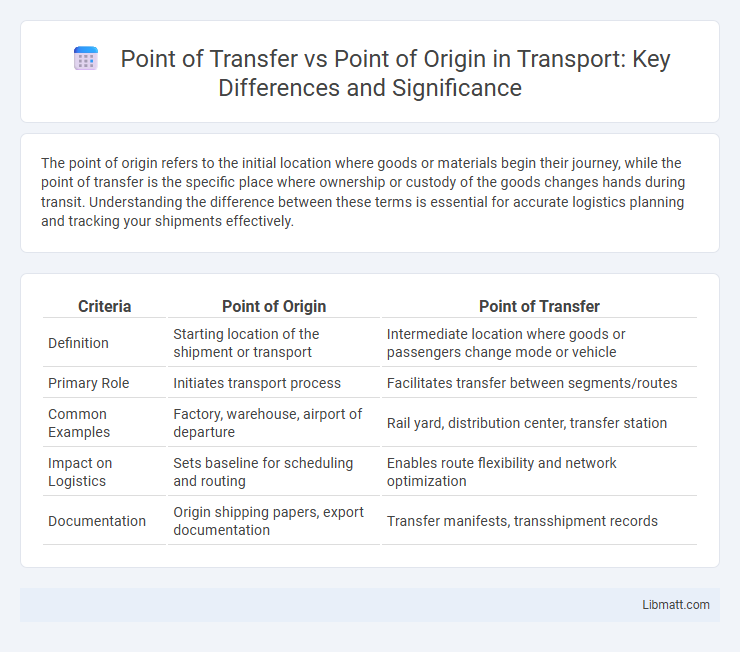The point of origin refers to the initial location where goods or materials begin their journey, while the point of transfer is the specific place where ownership or custody of the goods changes hands during transit. Understanding the difference between these terms is essential for accurate logistics planning and tracking your shipments effectively.
Table of Comparison
| Criteria | Point of Origin | Point of Transfer |
|---|---|---|
| Definition | Starting location of the shipment or transport | Intermediate location where goods or passengers change mode or vehicle |
| Primary Role | Initiates transport process | Facilitates transfer between segments/routes |
| Common Examples | Factory, warehouse, airport of departure | Rail yard, distribution center, transfer station |
| Impact on Logistics | Sets baseline for scheduling and routing | Enables route flexibility and network optimization |
| Documentation | Origin shipping papers, export documentation | Transfer manifests, transshipment records |
Introduction to Point of Transfer and Point of Origin
Point of Transfer refers to the location where goods or services change custody during transportation or delivery, ensuring accurate tracking and accountability. Point of Origin is the starting location where the shipment or production begins, crucial for determining supply chain logistics and cost calculation. Understanding the distinction between these two points helps optimize your inventory management and delivery efficiency.
Defining Point of Origin
The point of origin refers to the location where goods, shipments, or services initially begin their journey or production process. It serves as a critical reference for logistics, customs, and regulatory compliance, impacting tariffs, duties, and transportation costs. Understanding your shipment's point of origin ensures accurate tracking and efficient supply chain management.
Explaining Point of Transfer
Point of transfer refers to the location where goods or passengers are handed off from one mode of transport or carrier to another during a journey. This crucial juncture ensures continuity and coordination in logistics or travel, minimizing delays and maintaining the integrity of your shipment or travel plans. Understanding the point of transfer helps optimize routing efficiency and enhances supply chain transparency.
Key Differences Between Point of Origin and Point of Transfer
The point of origin refers to the initial location where goods or shipments are dispatched, while the point of transfer is the intermediate site where cargo changes hands or transportation modes during transit. Key differences include that the point of origin is associated with the shipment's commencement and legal responsibility, whereas the point of transfer involves logistics handling and redistribution without changing ownership. Understanding these distinctions optimizes supply chain management and improves tracking accuracy throughout the delivery process.
Importance in Forensic Investigations
The distinction between point of transfer and point of origin is crucial in forensic investigations for accurately reconstructing crime scenes and establishing timelines. Identifying the point of origin helps determine where a crime or event initially occurred, while the point of transfer reveals where evidence was moved or deposited, aiding in tracking suspect movements. Precise analysis of these points supports linking suspects to crime scenes and validating witness testimonies using trace evidence and transfer patterns.
Real-World Examples and Case Studies
The distinction between point of transfer and point of origin plays a crucial role in logistics and supply chain management, as demonstrated by Amazon's distribution network where goods move from fulfillment centers (point of origin) to regional hubs (point of transfer) before reaching customers. In air cargo, FedEx exemplifies this by routing packages through central sorting facilities (transfer points) to optimize delivery times compared to direct shipping from sender locations (origins). Case studies from Maersk shipping logistics reveal cost efficiencies achieved by identifying strategic transfer points that reduce transportation distances and improve cargo consolidation over direct shipments from multiple origins.
Impact on Crime Scene Analysis
The point of transfer, where evidence moves from one location or object to another, significantly influences the interpretation of crime scenes by revealing connections between suspects, victims, and locations. Distinguishing the point of transfer from the point of origin helps forensic experts determine the sequence of events and reconstruct activities within the crime scene. Your ability to accurately identify these points enhances the reliability of evidence and supports the overall analytical conclusions in criminal investigations.
Common Challenges and Misconceptions
Common challenges in distinguishing point of transfer from point of origin include confusion about where liability and responsibility shift during shipping or contractual processes. Misconceptions often arise when parties assume the point of origin always defines ownership transfer, ignoring that the point of transfer might occur later, such as at a designated delivery location. Understanding your specific terms and contract clauses prevents disputes by clarifying when and where responsibility changes hands.
Best Practices for Identifying Each Point
Identifying the point of transfer involves pinpointing the exact location or event where goods or services change hands between parties, often marked by shipping documents or contractual terms. The point of origin is best identified by tracing the initial source or location where the goods or raw materials are produced or extracted, emphasizing supplier documentation and provenance verification. Accurate differentiation relies on integrating supply chain data, legal definitions, and logistics tracking systems to ensure clarity in transaction responsibilities and tax obligations.
Conclusion: Significance in Evidence Interpretation
The distinction between the point of transfer and the point of origin is crucial in forensic science, as it directly impacts the accuracy of evidence interpretation. Understanding where physical evidence was transferred helps establish relationships between suspects, victims, and crime scenes, while recognizing the point of origin confirms the source of that evidence. Your ability to differentiate these points enhances the reliability of conclusions drawn during investigations and legal proceedings.
point of transfer vs point of origin Infographic

 libmatt.com
libmatt.com